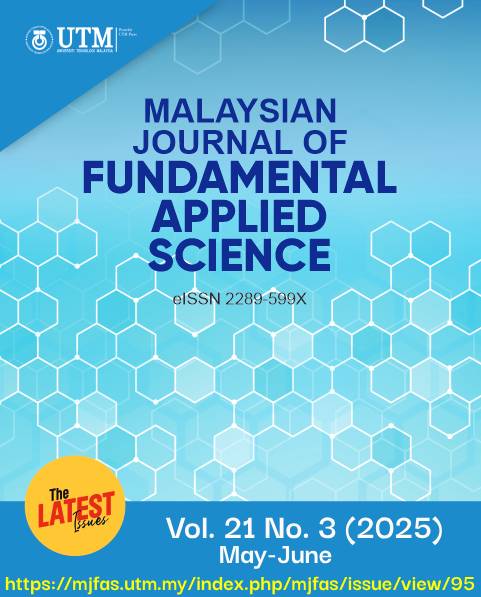Interpolation Technique in Solving Second Rank Polarization Tensor with Error Analysis
DOI:
https://doi.org/10.11113/mjfas.v21n3.4143Keywords:
Perturbation theory, error analysis, polarization tensor, linear element integration.Abstract
The Polarization Tensor (PT) serves as a fundamental property used to characterize the shape, size, and orientation of geometric shapes. Widely employed in engineering, particularly in electrical and magnetic domains for various objects with diverse metallic properties, PT has emerged as a valuable tool for researchers. Hence, this paper aims to provide a derivation of error analysis concerning high gradient problem of the first order PT. The derivation of error analysis is based on the numerical integration scheme which is Gaussian Quadrature. The numerical approximation of first order PT includes some errors due to computational approximations. Therefore, it is crucial to develop a method for estimating these errors to understand real-time inaccuracies, rather than just looking at errors after the computation is complete. The perturbation theory is used as a fundamental key for the derivation and representation of error in the PT problem. The derivation of the error analysis implemented the concept of Taylor series expansion of a function. Notably, our findings confirm that the computed PT error aligns with perturbation theory expectations. Our analysis prioritizes assessing the relative error in both data and computed solutions over norm-based evaluations, thus obviating dependency on problem-specific condition numbers. Future research directions include introducing variability in conductivity scenarios, which will further describe the robustness of algorithms developed in this paper.
References
Amad, A. A. S., Ledger, P. D., Betcke, T., & Praetorius, D. (2021). Accurate benchmark computations of the polarizability tensor for characterising small conducting inclusions. arXiv. http://arxiv.org/abs/2106.15157
Ammari, H., & Kang, H. (2007). Polarization and moment tensors (Vol. 162). Springer. https://doi.org/10.1007/978-0-387-71566-7
Ammari, H., Kang, H., & Kim, K. (2005). Polarization tensors and effective properties of anisotropic composite materials. Journal of Differential Equations, 215, 401–428. https://doi.org/10.1016/j.jde.2004.09.010
Bahuriddin, N. S., Muminov, M., Khairi, T., Khairuddin, A., Rohaizad, W., & Ibrahim, W. (2021). An extended method for fitting the first order polarization tensor to a spheroid. Advanced Research in Applied Sciences and Engineering Technology, 1(1), 8–17. https://doi.org/10.37934/araset.23.1.817
Capdeboscq, Y., Karrman, A. B., & Nedelec, J. C. (2012). Numerical computation of approximate generalized polarization tensors. Applicable Analysis, 91(6), 1189–1203. https://doi.org/10.1080/00036811.2011.641175
Čavka, D., Poljak, D., & Peratta, A. (2011). Comparison between finite and boundary element methods for analysis of electrostatic field around human head generated by video display units. Journal of Communications Software and Systems, 7(1), 22–28. https://doi.org/10.24138/jcomss.v7i1.184
Jin, Z., Qin, G., Fan, H., Huang, R., Chen, Z., Zhao, Q., et al. (2021). Boundary-element analysis of magnetic polarization tensor for metallic cylinder. IEEE Access, 9, 63250–63256. https://doi.org/10.1109/ACCESS.2021.3075342
Khairuddin, T. K. A., Ledger, P. D., & Lionheart, W. R. B. (2015). Investigating the polarization tensor to describe and identify metallic objects. Lecture Notes in Engineering and Computer Science, 2217, 122–127.
Khairuddin, T. K. A., & Lionheart, W. R. B. (2013a). Computing the first order polarization tensor: Welcome BEM++! Menemui Matematik, 35, 15–20.
Khairuddin, T. K. A., & Lionheart, W. R. B. (2013b). Fitting ellipsoids to objects by the first order polarization tensor. Applied Mathematical and Computer Intelligence, 4(1), 44–53.
Khairuddin, T. K. A., & Lionheart, W. R. B. (2015). Numerical comparisons for the approximated first order polarization tensor for ellipsoids. Applied Mathematical and Computer Intelligence, 4(1), 341–354.
Khairuddin, T. K. A., Yunos, N., Aziz, Z. A., Ahmad, T., & Lionheart, W. R. B. (2017). Classification of materials for conducting spheroids based on the first order polarization tensor. Journal of Physics: Conference Series, 890(1), 012035. https://doi.org/10.1088/1742-6596/890/1/012035
Khairuddin, T. K. A., Yunos, N. M., & Lionheart, W. R. B. (2018). Classification of material and type of ellipsoid based on the first order polarization tensor. Journal of Physics: Conference Series, 1123(1), 012035. https://doi.org/10.1088/1742-6596/1123/1/012035
Lu, M., Zhao, Q., Hu, P., Yin, W., & Peyton, A. J. (2015). Prediction of the asymptotical magnetic polarization tensors for cylindrical samples using the boundary element method. 2015 IEEE Sensors Applications Symposium Proceedings, 1–4. https://doi.org/10.1109/SAS.2015.7133631
Wilson, B. A., & Ledger, P. D. (2021). Efficient computation of the magnetic polarizability tensor spectral signature using proper orthogonal decomposition. International Journal for Numerical Methods in Engineering, 122(8), 1940–1963. https://doi.org/10.1002/nme.6610
Makkonen, J., Marsh, L. A., Vihonen, J., Järvi, A., Armitage, D. W., Visa, A., & Peyton, A. J. (2014). KNN classification of metallic targets using the magnetic polarizability tensor. Measurement Science and Technology, 25(5), 055105. https://doi.org/10.1088/0957-0233/25/5/055105
Marsh, L. A., Ktistis, C., Järvi, A., Armitage, D. W., & Peyton, A. J. (2013). Three-dimensional object location and inversion of the magnetic polarizability tensor at a single frequency using a walk-through metal detector. Measurement Science and Technology, 24(4), 045102. https://doi.org/10.1088/0957-0233/24/4/045102
Marsh, L. A., Ktistis, C., Järvi, A., Armitage, D. W., & Peyton, A. J. (2014). Determination of the magnetic polarizability tensor and three dimensional object location for multiple objects using a walk-through metal detector. Measurement Science and Technology, 25(5), 055107. https://doi.org/10.1088/0957-0233/25/5/055107
Pólya, G. (1947). A minimum problem about the motion of a solid through a fluid. Proceedings of the National Academy of Sciences, 33(7), 218–221. https://doi.org/10.1073/pnas.33.7.218
Pólya, G., & Szegö, G. (1953). Isoperimetric inequalities in mathematical physics. Bulletin of the American Mathematical Society, 59(6), 588–602. https://doi.org/10.1090/S0002-9904-1953-09777-9
Yunos, N. M., Khairuddin, T. K. A., Aziz, Z. A., Ahmad, T., & Lionheart, W. R. B. (2017). Identification of a spheroid based on the first order polarization tensor. Journal of Physics: Conference Series, 890(1), 012035. https://doi.org/10.1088/1742-6596/890/1/012035
Downloads
Published
Issue
Section
License
Copyright (c) 2025 Nurfarrisha Asnida Khairul Akmar, Suzarina Ahmed Sukri, Hoe Yeak Su, Taufiq Khairi Ahmad khairuddin

This work is licensed under a Creative Commons Attribution-NonCommercial 4.0 International License.




















